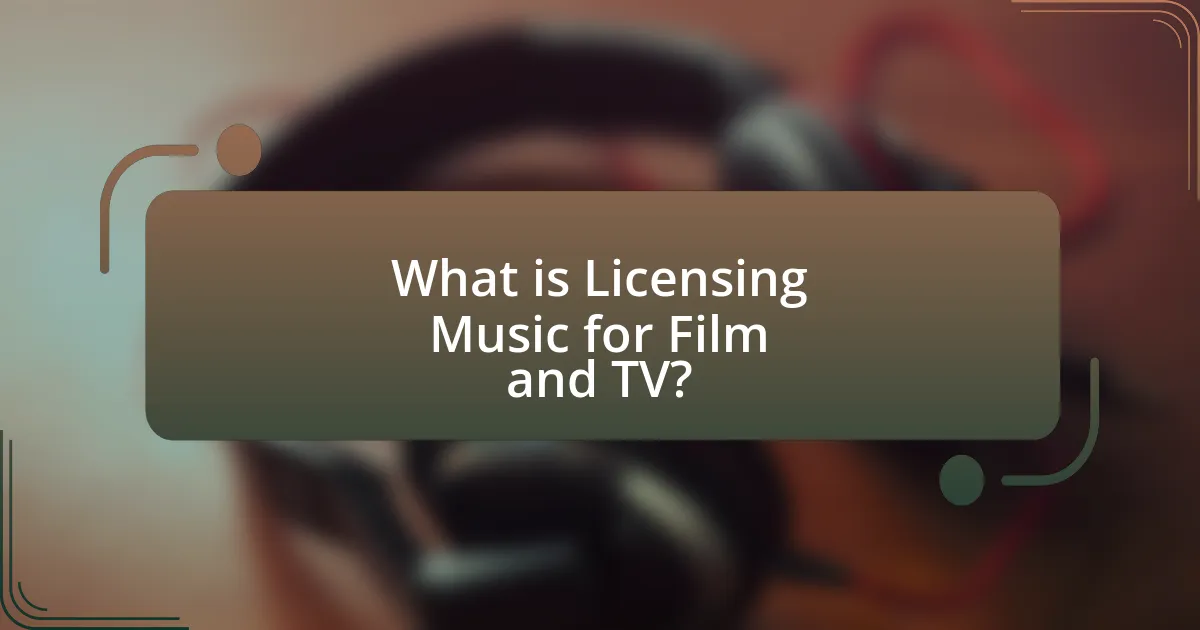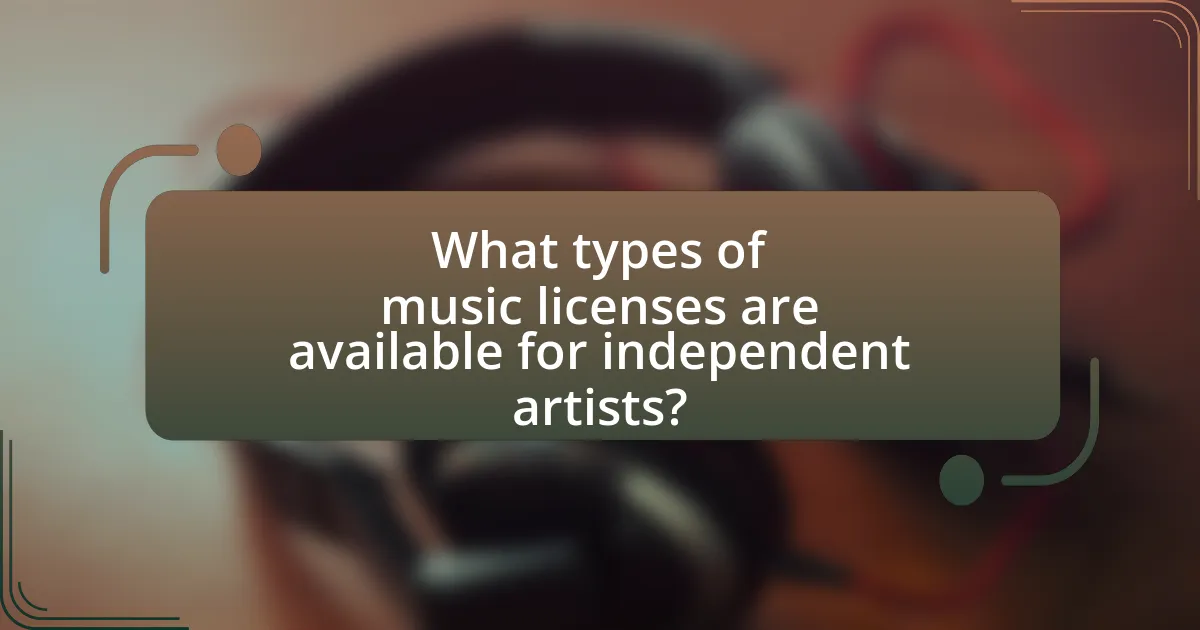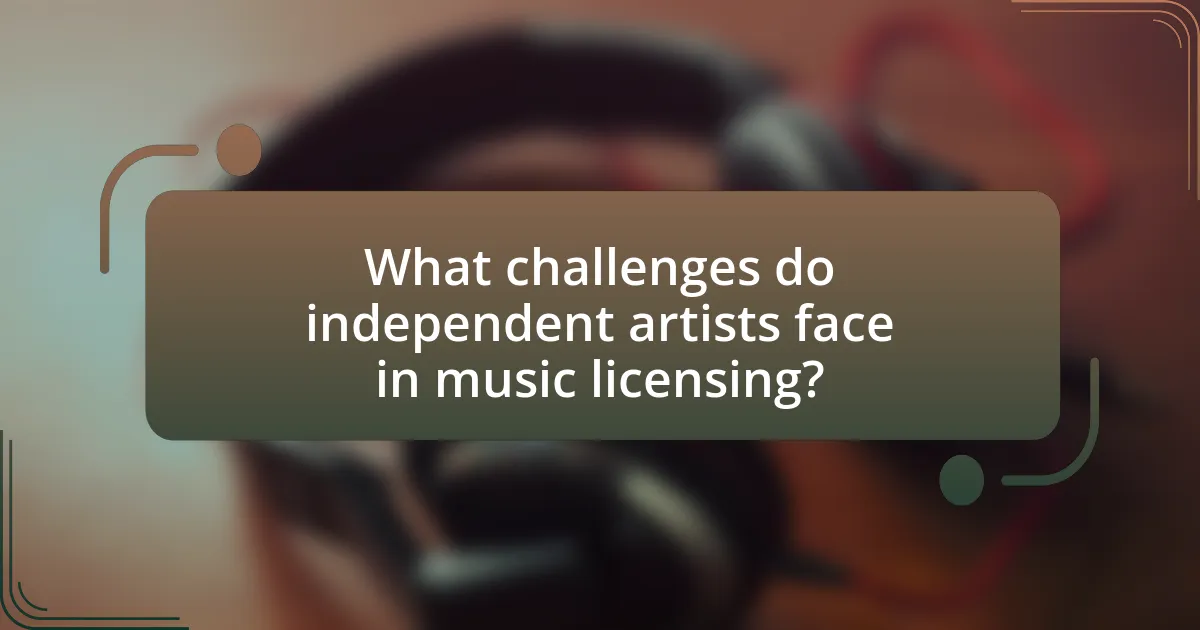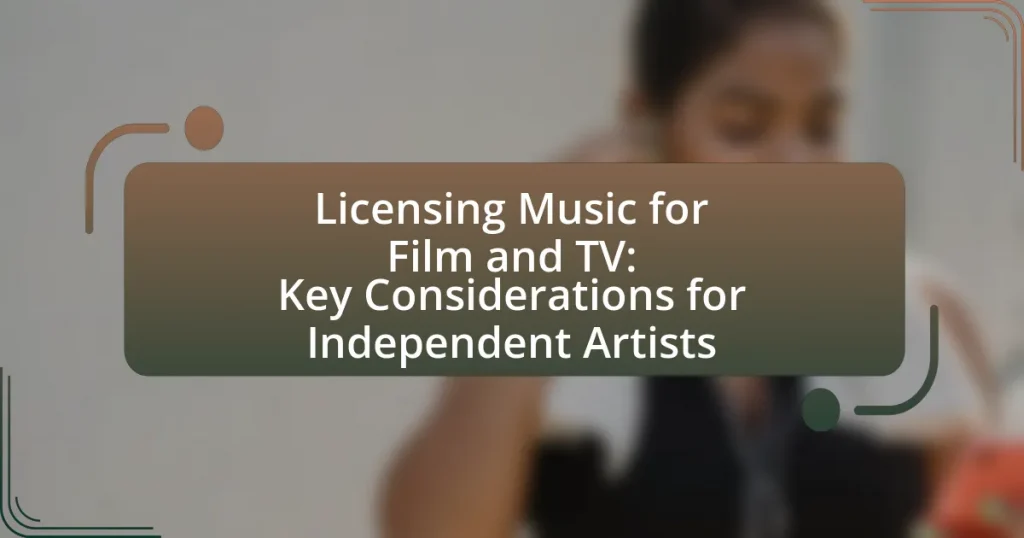Licensing music for film and TV is a critical process that involves obtaining legal permission to use music in audiovisual productions, ensuring compliance with copyright laws. The article outlines the licensing process for independent artists, detailing key steps such as identifying the type of license needed, negotiating terms, and obtaining permissions. It emphasizes the importance of music licensing for protecting artists’ rights and enhancing the emotional impact of visual media. Additionally, the article discusses the various types of licenses available, the challenges independent artists face, and best practices for successful music licensing, including networking and promoting music effectively.

What is Licensing Music for Film and TV?
Licensing music for film and TV is the process of obtaining legal permission to use a piece of music in audiovisual productions. This involves negotiating terms with the copyright holder, which can include songwriters, publishers, or record labels, to ensure that the music is used in compliance with copyright laws. The licensing agreement typically specifies how the music will be used, the duration of use, and any financial compensation involved. According to the U.S. Copyright Office, music licensing is essential for protecting the rights of creators while allowing filmmakers and producers to enhance their projects with music.
How does the licensing process work for independent artists?
The licensing process for independent artists involves obtaining permission to use their music in various media, such as film and television. Independent artists typically start by registering their works with a performing rights organization (PRO) to ensure they receive royalties when their music is played publicly. After registration, artists can negotiate licensing agreements directly with producers or through music libraries that facilitate placements. These agreements outline the terms of use, including duration, territory, and compensation. According to the American Society of Composers, Authors and Publishers (ASCAP), proper licensing is crucial for artists to protect their intellectual property and earn revenue from their work.
What are the key steps involved in music licensing?
The key steps involved in music licensing include identifying the type of license needed, negotiating terms, obtaining permissions, and ensuring proper documentation. First, artists must determine whether they need a synchronization license for film and TV or a mechanical license for distribution. Next, they negotiate terms such as fees and usage rights with the rights holder. After reaching an agreement, artists must obtain written permission to use the music, which serves as legal protection. Finally, maintaining proper documentation of all agreements is crucial for future reference and compliance with copyright laws. These steps ensure that artists can legally use music while protecting their rights and interests.
How do independent artists navigate the licensing landscape?
Independent artists navigate the licensing landscape by understanding copyright laws, utilizing digital platforms for distribution, and engaging with licensing agencies. They often educate themselves on the specifics of music rights, including synchronization and mechanical licenses, to ensure proper usage of their work. For instance, platforms like SoundCloud and Bandcamp provide avenues for artists to showcase their music while retaining control over licensing agreements. Additionally, independent artists frequently collaborate with music supervisors and licensing companies to facilitate placements in film and TV, which can enhance their visibility and revenue. This approach is supported by the increasing number of independent films and series seeking original music, creating more opportunities for artists to license their work effectively.
Why is music licensing important for film and TV?
Music licensing is crucial for film and TV because it ensures that creators have the legal right to use music, protecting them from copyright infringement. This legal framework allows filmmakers and producers to incorporate music into their projects without facing potential lawsuits or financial penalties. Additionally, licensed music can enhance the emotional impact of a scene, contributing to storytelling and audience engagement. According to the U.S. Copyright Office, unauthorized use of music can lead to significant legal consequences, emphasizing the importance of proper licensing in the industry.
What legal protections does licensing provide for artists?
Licensing provides legal protections for artists by granting them exclusive rights to their work, ensuring that unauthorized use is prohibited. This exclusivity allows artists to control how their music is used in film and television, protecting their intellectual property. Additionally, licensing agreements typically include terms that outline compensation, usage rights, and duration, which further safeguards the artist’s financial interests and creative integrity. By formalizing these agreements, artists can take legal action against infringement, reinforcing their rights under copyright law.
How does licensing impact the distribution of music in media?
Licensing significantly impacts the distribution of music in media by determining the legal permissions required for using a piece of music in various formats, such as film, television, and online platforms. When music is licensed, it allows creators and producers to legally incorporate the music into their projects, ensuring that artists receive compensation and recognition for their work. For instance, a synchronization license is necessary for pairing music with visual media, and without it, the distribution of that media could lead to copyright infringement, resulting in legal consequences. According to the U.S. Copyright Office, unauthorized use of copyrighted music can lead to substantial fines and loss of distribution rights, highlighting the critical role licensing plays in protecting both the rights of artists and the interests of media distributors.

What types of music licenses are available for independent artists?
Independent artists can access several types of music licenses, including synchronization licenses, mechanical licenses, performance licenses, and master use licenses. Synchronization licenses allow the use of music in audiovisual projects, such as films and TV shows, requiring permission from the copyright holder. Mechanical licenses are necessary for the reproduction of music on physical formats or digital downloads, ensuring artists receive royalties. Performance licenses are needed for public performances of music, covering venues and broadcasts, while master use licenses grant permission to use a specific recording of a song in a project. Each license type serves a distinct purpose in the music industry, facilitating the legal use of music while protecting the rights of artists.
What are the differences between synchronization and master licenses?
Synchronization licenses and master licenses serve different purposes in music licensing. A synchronization license grants permission to use a composition (the music and lyrics) in conjunction with visual media, such as films or TV shows. In contrast, a master license provides the rights to use a specific recording of that composition, allowing the licensee to utilize the actual sound recording in the visual media.
For example, when a filmmaker wants to use a song in a movie, they need to obtain both a synchronization license for the song’s composition and a master license for the specific recording they wish to use. This distinction is crucial for independent artists, as both licenses may involve separate negotiations and fees, impacting the overall cost and process of licensing music for film and TV.
How do synchronization licenses work in film and TV?
Synchronization licenses allow filmmakers and television producers to legally use a piece of music in their visual media. These licenses are essential because they grant the right to synchronize music with moving images, ensuring that the rights holders of the music are compensated for its use. Typically, the process involves negotiating terms with the copyright owner, which can include the songwriter, publisher, or record label, and agreeing on a fee that reflects the music’s value and the project’s budget. The necessity of synchronization licenses is underscored by copyright law, which protects the intellectual property of music creators, requiring permission for any use in film or TV.
What is the significance of master licenses for artists?
Master licenses are crucial for artists as they grant the legal rights to use a specific recording of a song in various media, including film and television. This type of license allows artists to monetize their work by enabling its use in commercial projects, which can lead to increased exposure and revenue. For instance, when a song is featured in a popular film or TV show, it can significantly boost the artist’s visibility and sales. Additionally, master licenses ensure that artists receive royalties for the use of their recordings, providing a financial incentive for their creative efforts.
What are the common terms and conditions in music licensing agreements?
Common terms and conditions in music licensing agreements include the scope of use, duration, territory, payment terms, and rights granted. The scope of use specifies how the music can be utilized, such as in film, television, or advertisements. Duration defines the length of time the license is valid, while territory outlines the geographical areas where the music can be used. Payment terms detail the financial arrangements, including upfront fees and royalties. Rights granted clarify whether the license is exclusive or non-exclusive, affecting the ability of the artist to license the same music to others. These elements are essential for protecting the interests of both the licensor and licensee in the music licensing process.
What should artists look for in licensing contracts?
Artists should look for clear terms regarding rights, compensation, and duration in licensing contracts. Specifically, they need to ensure that the contract specifies the type of rights being granted, such as exclusive or non-exclusive rights, which directly impacts their ability to license the same work to others. Additionally, artists should verify the compensation structure, including upfront fees and royalties, to ensure fair remuneration for their work. The duration of the license is also crucial, as it defines how long the rights are granted and whether there are options for renewal. These elements are essential to protect the artist’s interests and ensure they retain control over their creative output.
How can independent artists negotiate better licensing terms?
Independent artists can negotiate better licensing terms by conducting thorough research on industry standards and leveraging their unique value proposition. Understanding the typical rates and terms for similar works allows artists to present informed counteroffers. Additionally, showcasing their audience reach and engagement can strengthen their negotiating position, as it demonstrates potential value to the licensee. According to a 2021 survey by the Music Industry Research Association, artists who actively engage in negotiations and present clear data about their marketability achieve more favorable terms, often securing higher royalties and better usage rights.

What challenges do independent artists face in music licensing?
Independent artists face several challenges in music licensing, primarily due to limited resources and industry knowledge. These artists often lack the financial backing and legal expertise that larger entities possess, making it difficult to navigate complex licensing agreements. Additionally, independent musicians may struggle with the intricacies of copyright law, which can lead to unintentional infringements or missed opportunities for licensing their work. According to a survey by the Music Industry Research Association, 70% of independent artists reported feeling overwhelmed by the licensing process, highlighting the need for accessible resources and support in this area.
How can independent artists overcome barriers to licensing?
Independent artists can overcome barriers to licensing by actively educating themselves about the licensing process and leveraging digital platforms for exposure. Understanding the legal requirements and types of licenses needed for film and TV can demystify the process, enabling artists to navigate it more effectively. Additionally, utilizing platforms like SoundCloud, Bandcamp, or licensing-specific services such as Musicbed can increase visibility and connect artists with potential licensors. According to a 2021 survey by the Music Licensing Collective, 70% of independent artists reported that increased knowledge of licensing significantly improved their chances of securing deals. This evidence supports the notion that education and strategic use of technology are crucial for overcoming licensing barriers.
What resources are available for independent artists seeking licenses?
Independent artists seeking licenses can access several resources, including licensing agencies, online platforms, and music libraries. Licensing agencies, such as ASCAP and BMI, provide guidance and facilitate the licensing process for artists. Online platforms like Songtradr and DistroKid offer services that help artists license their music for various media. Additionally, music libraries, such as AudioJungle and Epidemic Sound, allow artists to submit their work for licensing opportunities, providing a marketplace for their music to be used in film and TV projects. These resources are essential for independent artists to navigate the licensing landscape effectively.
How can networking help in the licensing process?
Networking can significantly enhance the licensing process by providing independent artists with valuable connections to industry professionals, such as music supervisors, producers, and other artists. These connections can lead to opportunities for collaboration, exposure, and access to projects that require licensed music. For instance, a study by the Music Industry Research Association found that 70% of music placements in film and TV come from personal relationships within the industry. This statistic underscores the importance of networking in facilitating introductions and recommendations that can expedite the licensing process for independent artists.
What are the best practices for successful music licensing?
The best practices for successful music licensing include understanding the legal framework, establishing clear agreements, and maintaining good relationships with music supervisors and producers. Understanding the legal framework ensures compliance with copyright laws, which is crucial for protecting the rights of the artist and the integrity of the music. Establishing clear agreements, including terms of use, payment structures, and duration of the license, helps prevent disputes and misunderstandings. Maintaining good relationships with music supervisors and producers can lead to more opportunities, as networking is essential in the industry. According to a survey by the Music Licensing Collective, 70% of music supervisors prefer working with artists who are proactive and communicative, highlighting the importance of relationship-building in successful music licensing.
How can independent artists effectively promote their music for licensing?
Independent artists can effectively promote their music for licensing by leveraging online platforms, networking with industry professionals, and utilizing targeted marketing strategies. Online platforms such as music licensing websites and social media allow artists to showcase their work to potential licensors. Networking at industry events and connecting with music supervisors can lead to valuable opportunities for placements. Additionally, targeted marketing strategies, including email campaigns and collaborations with other artists, can increase visibility and attract attention from filmmakers and advertisers. These methods are supported by the growing trend of independent artists successfully licensing their music, as evidenced by the rise of platforms like Songtradr and AudioJungle, which facilitate connections between artists and content creators.
What strategies can artists use to build relationships with music supervisors?
Artists can build relationships with music supervisors by networking at industry events and utilizing social media platforms. Networking at events such as film festivals, music conferences, and workshops allows artists to meet music supervisors face-to-face, fostering personal connections that can lead to collaboration opportunities. Additionally, engaging with music supervisors on platforms like LinkedIn and Twitter can help artists stay on their radar, as consistent interaction can demonstrate genuine interest and professionalism. According to a survey by the Music Supervisors Guild, 70% of music supervisors prefer to work with artists who have established a rapport through networking.
What practical tips can independent artists follow for music licensing?
Independent artists should ensure they understand the different types of music licenses available, such as synchronization licenses for film and TV, which allow the use of music in visual media. Additionally, they should register their works with a performing rights organization (PRO) to collect royalties from public performances and broadcasts. It is also crucial for artists to create clear contracts that outline the terms of use, including duration, territory, and compensation, to protect their rights. Furthermore, networking with industry professionals can provide valuable opportunities for licensing deals. According to the American Society of Composers, Authors and Publishers (ASCAP), proper licensing can significantly increase an artist’s revenue stream, highlighting the importance of these practices.
